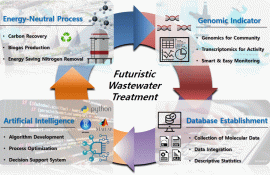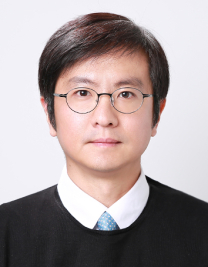- * 프린트는 Chrome에 최적화 되어있습니다. print

하폐수 처리의 패러다임은 에너지 중립적 상태와 이산화탄소의 제로 생산으로 이동하고 있습니다. 에너지 중립 하폐수 처리(Energy-Neutral Wastewater Treatment, ENWT)를 달성하기 위해 저의 연구 관심 분야는 에너지 중립 프로세스, 유전자 지표, 데이터베이스 구축 및 인공 지능입니다. 최종 결과로서 이루고자 하는 연구 목표는 ENWT에 초점을 맞추고 기후 변화에 대한 적응 방법으로 폐수 처리 프로세스를 최적화하는 것입니다. 첫 번째 하수처리 단계인 흡착(A-단계)은 하폐수에서 열량이 있는 가용성 유기 탄소 함량을 회수하기 위해 화학적으로 강화된 1차 처리(chemically enhanced primary treatment, CEPT) 및 고속 활성 슬러지(high-rate activated sludge, HRAS)와 같은 새로운 탄소 회수 공정이 시급히 요구됩니다. 포획된 유기 탄소는 바이오가스를 생산하기 위해 혐기성 소화(AD)로 보내집니다. 이러한 탄소 재순환에 의해 활성슬러지 공정에서 폭기 에너지를 포함하는 처리 비용을 대폭 절감할 수 있습니다. HRAS와 관련하여 저는 한국연구재단(NRF)으로부터 "하수에너지 회수를 위한 Feast-Famine 기작의 분자표지와 기계학습 모델 개발" 의 연구를 수주하였습니다(2021-2025). 분자지표 개발을 위해 미세전기영동, DNA/RNA 무결성 분석, Real-time qPCR, 디지털 PCR 및 차세대 염기서열분석 등 DNA 및 RNA의 고품질 분석을 운영하고 있습니다. 저의 연구는 정보통신기술(ICT)의 발전에 더 초점을 맞추고 있습니다. 예를 들어, ENWT의 모든 공정 운전 요소, 이화학적 정보, 미생물 정보를 포함하는 통합 데이터베이스(DB) 시스템을 구축할 수 있습니다. 통합 DB 시스템은 시민, 시당국, 운영기관의 이해관계자와 공유할 수 있다. 또한 기술통계(Descriptive Statistics)는 ENWT의 운용 현황 및 시계열 성능을 가시화하기 위한 DB의 핵심 기능입니다. 추가로, 우리 연구실은 세계적 수준의 환경유전체학 연구를 전개하고 있습니다. 현재 3세대 환경유전체학(2016~현재)으로 롱리드 시퀀싱 기술과 고도화된 딥러닝 알고리즘을 통해 미생물의 완전한 유전체를 구축하는 것이 가능합니다. 고성능 컴퓨팅 시설은 MAG(metagenome-assembled genome)라고 하는 in-silico-organized 게놈의 무결성과 오류 허용성을 위해 필수적입니다. 이 기술은 세균의 계통발생학적 분석에만 사용할 수 있는 16s rRNA 유전자의 한계를 극복하고 미생물의 기능을 충분히 설명할 수 있게 합니다. 통합된 게놈 정보를 활용하기 위해 머신 러닝 코드를 최적화하고 있으며, 이러한 유전체 입력 데이터를 효과적으로 요약하고 노이즈 신호를 제거하기 위한 인공지능 원천연구를 수행합니다.
The paradigm of wastewater treatment is shifting towards the energy-neutral status and net-zero production of carbon dioxide. To achieve the energy-neutral wastewater treatment (ENWT), my research interests are on four topics: energy-neutral process, genomic indicator, database establishment and artificial intelligence. My main research goals have been focused the ENWT and optimize the wastewater treatment processes as an adaptation method to climate change. As the first step of adsorption (A-stage), emerging carbon recovery processes such as chemically enhanced primary treatment (CEPT) and high-rate activated sludge (HRAS) are urgently required to recover suspended and soluble organic carbon contents from wastewater. The captured organic carbon is redirected to anaerobic digestion (AD) to produce biogas. By this carbon redirection, the treatment cost including aeration energy in the activated sludge process is largely saved due to the simple and easy removal of organic carbon instead of intensive aeration. Regarding HRAS, I received a fund from National Research Foundation of Korea (NRF) entitled “Molecular indicator and machine-trained model for core functions of feast-famine reaction utilized in sewage energy recovery” (2021-2025). For the high-quality analysis of DNA and RNA to develop the molecular indicator, advanced systems of micro-electrophoresis, DNA/RNA integrity analyzer, real-time qPCR, digital PCR and next generation sequencing are in operation. My research has been more focused on the advances of information and communication technology (ICT). For example, the integrated database (DB) system can be established including all process operation factors, physicochemical information and microorganism information of ENWT. The integrated DB system can be shared with stakeholders of citizens, city authority and operational organization. In addition, descriptive statistics is a core function of the designated DB to visualize the operational status and time-series performance of ENWT. In addition, my laboratory is developing the world-class environmental genomics research. As the current 3rd generation environmental genomics (2016-present), it is possible to construct complete genomes of microorganisms through long-read sequencing technology and advanced deep learning algorithms. High-performance computing facilities are essential for the integrity and error tolerance of in-silico-organized genomes, called metagenome-assembled genome (MAG). This technology overcomes the limitation of the 16s rRNA gene, which can only be used for phylogenetic analysis of bacteria, and allows to fully explain the function of microorganisms. To utilize the integrated genomic information, machine-learning codes are optimized to effectively summarize the genomic input data and remove the noise signals as an original technology of artificial intelligence.
Major research field
에너지 중립 하폐수 처리, 유전자 지표, 데이터베이스 구축, 인공 지능 / energy-neutral wastewater treatment, genomic indicator, database establishment, artificial intelligence
Desired field of research
고도 유전체 분석, 메타지놈 기반 지놈, 고성능 컴퓨팅 / advanced genomic analysis, metagenome-assembled genome, high-performance computing
Research Keywords and Topics
1) 폐수 처리의 에너지 중립성 / Energy neutrality of wastewater treatment
2) 미세조류를 이용한 탄소저장 / Carbon storage using microalgae
3) 에너지 절약형 질소 제거 / Energy-saving nitrogen removal
4) 바이오가스 생산을 위한 세균 군집 구조 / Bacterial community structure for biogas production
5) 시스템 최적화를 위한 머신러닝 / Machine learning for system optimization
Research Publications
1) J. Jeon, K. Cho, J. Kang, S. Park, O. U. E. Ada, J. Park, M. Song, V. L. Quang, H. Bae* (2022) Combined machine learning and biomolecular analysis for stability assessment of anaerobic ammonium oxidation under salt stress. Bioresource Technology, 127206.
2) D. Jeong, H. Bae* (2021) Insight into functionally active bacteria in nitrification following Na+ and Mg2+ exposure based on 16S rDNA and 16S rRNA sequencing, Science of the Total Environment, 758, 143592
3) H. Bae*, M. Choi, Y.C. Chung, S. Lee, Y.J. Yoo* (2017) Core-shell structured poly (vinyl alcohol)/sodium alginate bead for single-stage autotrophic nitrogen removal. Chemical Engineering Journal, 332, 408-416
Patents
1) 배효관, 전준범, 박수인, 옥페테우첸나 에스더 에이다, 송민수, 박지혜, 2021, 머신러닝 모델을 이용한 하폐수처리공정 안정성 평가 방법 및 시스템 (한국, 출원, 10-2021-0121984)
2) 배효관, 오정은, 응우옌티민, 2020, 인공신경망 모델을 이용한 토양 오염원 예측 방법 (한국, 출원, 10-2020-0091768)
국가과학기술표준분류
- EH. 환경
- EH02. 물관리
- EH0205. 하/폐수 고도처리/핵심요소기술
국가기술지도분류
- 환경/에너지 프론티어 진흥
- 030200. 수질관리 및 수자원 확보기술
녹색기술분류
- 에너지원기술
- 재생에너지
- 221. 바이오 에너지생산 요소기술 및 시스템 기술
6T분류
- ET 분야
- 환경기반
- 050113. 수질오염처리 및 재이용기술




